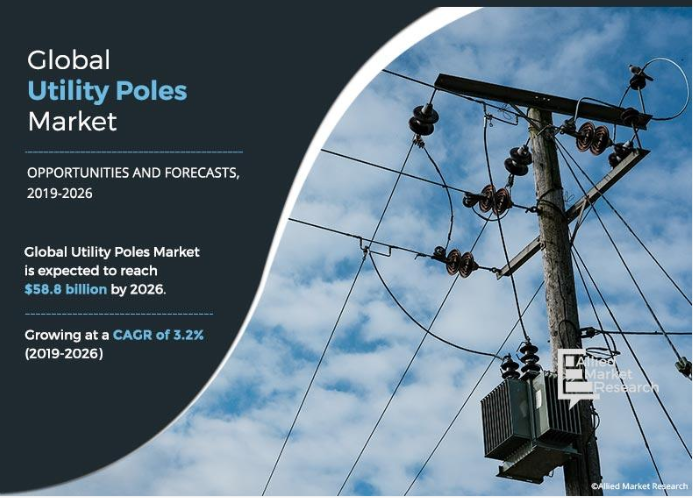The global utility poles market was valued at $45.6 billion in 2018, and is projected to reach $58.8 billion by 2026, growing at a CAGR of 3.2% from 2019 to 2026.

Utility poles, also known as power poles or telephone poles, are tall, slender structures typically made of wood, steel, or concrete, and they are commonly used to support overhead utility lines, such as electrical power lines, telephone lines, and cable television lines. These poles serve a crucial role in the distribution of essential services like electricity, telecommunications, and cable television.
Download Sample PDF: https://www.alliedmarketresearch.com/request-sample/5939
Some of the major market players studied and profiled in the global utility poles market are Valmont Industries Inc., Skipper Ltd., Nippon Concrete Industries Co. Ltd., El Sewedy Electric Company, Hill & Smith Holdings PLC, Stella-Jones, FUCHS Europoles GmbH, Omega Factory, Pelco products Inc., RS Technologies Inc., and others.
Materials:
- Wooden Poles: Historically, utility poles were primarily made of wood, often treated with preservatives to increase durability. Wood is still a common material for utility poles, especially in rural and residential areas.
- Steel Poles: Steel utility poles are known for their strength and durability. They are commonly used in urban and industrial settings.
- Concrete Poles: Concrete utility poles offer excellent strength and longevity, making them suitable for areas with harsh environmental conditions or high wind loads.
By type, distribution pole emerged as the global leader in 2018 and a similar segment likely to continue its dominance on the global utility poles market. Electric distribution activities required a repeated number of poles as per the electricity demand which drives the growth of this segment.
By material, wood is the largest revenue-generating segment in 2018. Wood is the pioneer material in the pole making industry due to which it is still used significantly across the globe. However,
By application, energy transmission and distribution is the major segment accounted for around 70% market share in 2018. Utility poles are mainly required in the energy transmission and distribution activities that make this segment the largest one among others.
Composite utility poles offer the longest lifespan due to which it is expected to register highest CAGR during the forecast period.
Some of the other factors driving the adoption of utility poles are the expansion of existing electricity networks, increase in electricity access rate in developing and underdeveloped countries, and the introduction of monopoles.
Monopoles are the latest invention in this market, however, lack of awareness associated with them is holding the market from maximizing the growth.
Enquiry Before Buying: https://www.alliedmarketresearch.com/purchase-enquiry/5939
Technological Advancements:
- Advancements in materials and technology have led to innovations in utility poles, including composite materials that offer durability and resistance to rot.
- Smart utility poles equipped with sensors and communication technology are being developed to monitor infrastructure health and improve service reliability.
Composite poles are also introduced in the market that is showing greater potential for the coming years.
This pole type has superior properties and is lightweight as compared to other poles, due to which composite poles are expected to register the highest CAGR during the forecast period.
Steel’s material profile is approved as a green material and the market has seen different growth perspectives thereafter.
Most of the aged wooden utility poles have started to replace from steel poles due to greater benefits such as ease of installation, reliability, durability, life cycle cost, and environmental considerations.
Currently, there are more than 150 utility poles are in service in North America (of which more than 70% are wooden) and around 2.5 million are getting replaced by steel poles. As a result, steel-based poles likely to have a promising future during the forecast period.
Utility pole is an end to end connection of electrical wires that carries and distributes electricity as per the convenience. Therefore, utility poles are designed to be durable in nature.
The normal life cycle of a utility pole ranges from 30 to 50 years but this life span varies based on the material used.
Buy This Report (150 Pages PDF with Insights, Charts, Tables, and Figures): https://bit.ly/3Mc5pD4
Wood poles were preferred mostly in response to material suitability but gradually wooden poles are getting replaced by steel and now composite based poles due to enhanced properties and benefits associated with them.
About Us
Allied Market Research (AMR) is a full-service market research and business-consulting wing of Allied Analytics LLP based in Portland, Oregon. Allied Market Research provides global enterprises as well as medium and small businesses with unmatched quality of “Market Research Reports” and “Business Intelligence Solutions.” AMR has a targeted view to provide business insights and consulting to assist its clients to make strategic business decisions and achieve sustainable growth in their respective market domain.
Pawan Kumar, the CEO of Allied Market Research, is leading the organization toward providing high-quality data and insights. We are in professional corporate relations with various companies and this helps us in digging out market data that helps us generate accurate research data tables and confirms utmost accuracy in our market forecasting. Each and every data presented in the reports published by us is extracted through primary interviews with top officials from leading companies of domain concerned. Our secondary data procurement methodology includes deep online and offline research and discussion with knowledgeable professionals and analysts in the industry.
Contact:
David Correa
1209 Orange Street,
Corporation Trust Center,
Wilmington, New Castle,
Delaware 19801 USA.
Int’l: +1-503-894-6022
Toll Free: +1-800-792-5285
Fax: +1-800-792-5285
help@alliedmarketresearch.com
Web: www.alliedmarketresearch.com
Allied Market Research Blog: